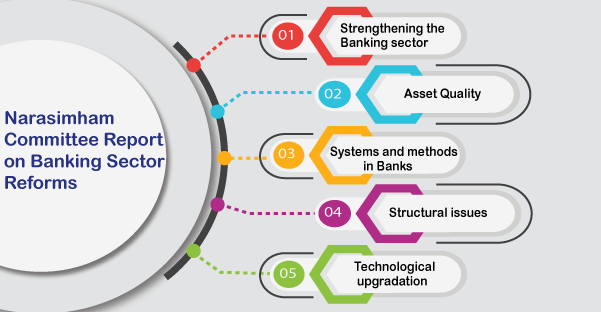Following the CFS’s recommendations in 1991, the government began a comprehensive financial system reform process in 1992-93. In December 1997, the government-appointed M. Narasimham to chair a new committee to reform the banking sector. The committee’s goal is made clear by the terms of reference it was given when it was formed:
“To review the progress of banking sector reforms to date and chart a program of financial sector reforms necessary to strengthen India’s financial system and make it internationally competitive.
Narasimham Committee-II
The Narasimham Committee-II (popularly called by the Government of India) handed over its reports in April 1998, which included the following major suggestions:
- Stronger banks and DFIs (development financial institutions, i.e., AIFIs) should be merged, while weaker and unviable ones should be closed, resulting in a stronger banking system.
- A 3-tier banking structure was suggested after mergers. The first and second tiers were to take care of the banking needs of the corporate sector in the economy, (a) Tier-1 to have 2 to 3 banks of international orientation; (b) Tier-2 to have 8 to 10 banks of national orientation; and (c) Tier-3 to have a large number of local banks.
- Higher norms of Capital-to-Risk—Weighted Adequacy Ratio (CRAR) suggested—increased to 10 percent.
- Budgetary recapitalization of the PSBs is not viable and should be abandoned.
- The legal framework of loan recovery should be strengthened (the government passed the SARFAESI (Act, 2002).
- Net NPAs for all banks are suggested to be cut down to below 5 percent by 2000 and 3 percent by 2002.
- Rationalization of branches and staffs of the PSBs suggested.
- Licencing to new private banks (domestic as well as foreign) was suggested to continue.
- Banks’ boards should be depoliticized under RBI supervision.
- Board for financial Regulation and Supervisions (BFRS) should be set up for the whole banking, financial, and the NBFCs in India.
DRI
The differential rate of interest (DRI) is a government-sponsored lending program that requires all public sector banks in India to lend 1% of total lending to ‘the poorest among the poor at a 4% annual interest rate.
Priority Sector Lending
All Indian banks must adhere to the mandatory priority sector lending target (PSL). Agriculture, small and medium enterprises (SMEs), road and water transport, retail trade, small business, small housing loans (less than X10 lakhs), software industries, self-help groups (SHGs), agro-processing, distressed urban poor, and indebted non-institutional debtors, as well as SCs, STs, and other weaker sections of society are currently the priority sectors in India. In 2007, the RBI added five minorities to the PSL: Buddhists, Christians, Muslims, Parsis, and Sikhs. The RBI added medium enterprise, sanitation, and renewable energy to its new guidelines in March 2015.
The PSL Target
The banks operating in India must meet the PSL target in the following way:
- Every year, Indian banks (both public and private sector banks) must lend 40 percent of their total lending to the priority sector. There is also a sub-target: 18% of total lending must go to agriculture, and 10% of total lending or 25% of priority sector lending (whichever is higher) must be lent out to the poorer sections. Other priority sector areas to be covered in the left amount, i.e. 12 percent of total lending.
- Foreign banks with fewer than 20 branches are only required to meet a 32 percent PSL target, which includes sub-targets for exports (12 percent) and small and medium businesses (12 percent) (10 percent). It means they’ll have to use the remaining 10% of their total lending to fund other PSL areas (lesser burden).
For the benefit of the banking industry in particular and the economy in general, the Committee on Financial System (CFS, 1991) recommended cutting it to 10% for all banks and completely eliminating the policy. The committee also recommended that the sectors covered by PSL be rotated every three years. The government has done nothing except reduce the PSL target for foreign banks from 40% to 32%. (remaining same for those which have less than 20 branches). Meanwhile, the PSL has gained some new features.

